
DOWNLOAD
DATE
Contact
Improving productivity is a critical element of the journey telcos must take to become ambidextrous — and improving productivity is about going way beyond cost-cutting. In this Viewpoint, we discuss a transformative approach that we call the “Productivity RACE” (Radical, Accelerated, Continuous, and Effective). This framework sets out to improve and sustain business productivity, while addressing commonly observed challenges and barriers to successful execution of productivity measures. We also elaborate on how telco executives can execute sustainable productivity transformations within their companies.
PRODUCTIVITY IMPROVEMENT: A MUST FOR TELCOS
Telco executives face myriad dilemmas in the post-COVID-19 era when addressing fundamental questions about business performance. Telcos across all markets operate in a highly volatile, uncertain, complex, and ambiguous (VUCA) environment: high inflation, signals of economic downturn, resource scarcities (including chip and skill shortages), accelerated technology dynamics (e.g., artificial intelligence [AI], machine learning [ML], data), along with hypercompetition from digital-native global players that successfully leverage accelerated technology dynamics on AI, data, and so on, to operate with a high rate of productivity.
Telcos also battle frequent changes to regulations, which opens the market up to hypercompetition and pressures industry players to constantly become more productive and efficient. Moreover, telcos’ core mission requires them to make large-scale investments in infrastructure (e.g., 5G, fiber, and data centers). These investments do not yield immediate cash flows, which makes even less cash available for the further investments required to drive revenue growth. Breaking this cycle of investment-growth-earnings-cashflow is one of the most critical strategic challenges industry players encounter.
To overcome this paradox, telcos need to become ambidextrous and aspire to deliver better performance in the current context, while constantly investing in building capabilities for future business growth. They should aim to deliver revenue growth while improving profitability, increasing cash flows for investments, and developing future-ready capabilities and infrastructure. In the true spirit of an ambidextrous organization, telcos must focus on scale and productivity on one hand, and speed and creativity on the other. In this Viewpoint, we delve into how telcos can improve productivity in their journey to become truly ambidextrous.
PRODUCTIVITY: BEYOND COST EFFICIENCIES
Productivity should not be mistaken for traditional short-term cost-cutting. Typical cost-cutting programs do not guarantee sustainable improvement in business performance, as evidenced by multiple transformation stories. Such efforts mostly yield a one-time impact on earnings before interest, taxes, depreciation, and amortization (EBITDA) but do not address the root causes of inefficiency. On the contrary, a broader cost-cutting initiative often adversely impacts the drivers of business growth. For example, cutting IT costs could slow down innovation in product development and modularization of capabilities, which in turn impacts the agility of IT delivery. Delays in product launches and innovation can result in both lower revenues and lower margins, bringing the EBITDA curve to its original trajectory, with no long-term improvement.
Arthur D. Little (ADL) recommends an alternative transformative approach to telcos for achieving sustained business performance improvement — the Productivity RACE (Radical, Accelerated, Continuous, and Effective), which comprises an innovative approach to design and execute productivity improvement programs, while addressing commonly observed challenges and barriers to successful execution of transformation programs (see Figure 1).
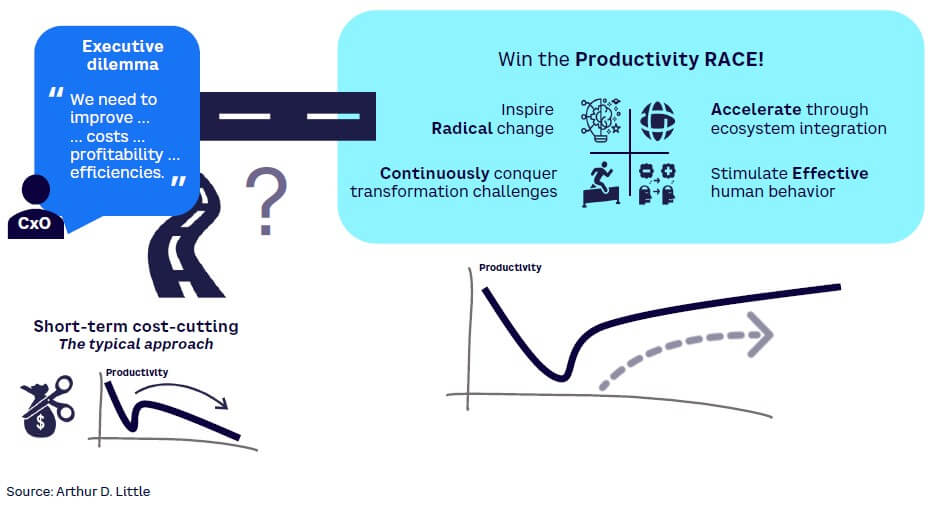
PRODUCTIVITY AMBITION & MANAGEMENT AGENDA
Traditionally, few players in the telco industry have consistently placed long-term productivity enhancement on the board or executive agenda, as the focus often remains on short-term EBITDA and annual performance improvement efforts. In the emerging strategic context of VUCA environments, telco boards and executives must adopt a robust steering mechanism that provides a holistic picture of business performance, combining current performance along with evolution of the productivity indicators of the business.
Based on our observations and experience, ADL recommends using four productivity indicators and offers the following guidance for the potential ambition level of telcos:
-
EBITDA margin — assists in measuring the short-term (i.e., annual) achievement on productivity. The ambition level of telcos on this KPI should be at least 40%.
-
Return on capital employed (ROCE) — helps measure capital productivity and should be higher than 10%. The annual growth rate of this parameter should be at least 12%.
-
Growth rate of revenue per employee (RPE) — measures labor productivity. As it could vary by country context, we recommend setting a target on the annual growth rate of RPE of at least 10%.
-
Total shareholder return (TSR) — indicates the company’s long-term sustainable performance. The ambition level of telcos on this parameter should be higher than 10%. Unlisted telcos can replace this parameter with operating cash flow.
When looking at the 80th percentile of the top 100 telco operators globally by revenue, we observe substantial room for improvement on the productivity indicators (see Figure 2).
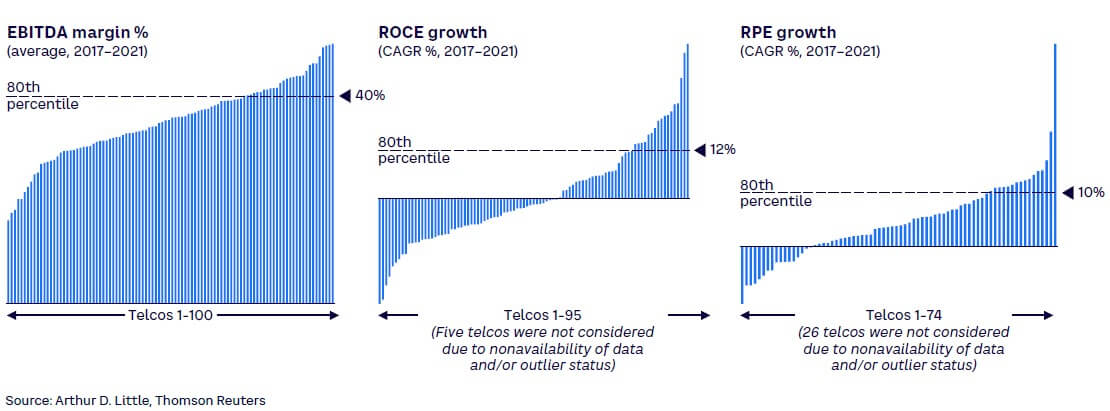
Few telcos perform well on all measures simultaneously, while many perform well on metrics that can be achieved through short-term cost-cutting, such as EBITDA and revenue/full-time equivalent (FTE) growth (see Figure 3). Therefore, it is essential to track all four measures simultaneously to ensure sustainable productivity improvement.
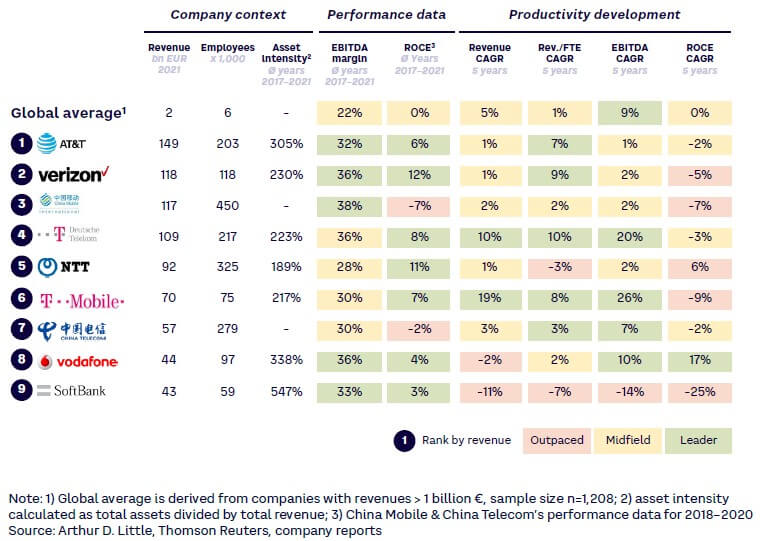
THE PRODUCTIVITY RACE: HOLISTIC TRANSFORMATION FOR TELCOS
The Productivity RACE is a systematic productivity improvement approach ensuring short-term and long-term benefits through the following:
-
Radical moves envision and ideate to go beyond incremental improvements.
-
Accelerated directions prioritize and plan transformation initiatives to overcome barriers.
-
Creative solutions make the unexpected happen and attain best-in-class productivity levels.
-
Effective results anchor and sustain continuous transformation.
The Productivity RACE aims to simultaneously address eight key challenges for radical and swift improvement, which telcos must address:
-
Idea. There is lack of ideas for radical improvement moves.
-
Complexity. Navigating the technology landscape is complex.
-
Stakeholder. Vision, direction, and financing do not align to management or stakeholder goals.
-
Silo. Working in silos focuses only on small ideas and incremental change.
-
Competence. The right people and skills to drive and implement transformation are not present.
-
Speed. Organization is “overcharged” due to speed of change.
-
Mobilization. Top-down focus does not activate local levels.
-
Culture. Overall culture prevents consistent change.
Challenges are typically present within each telco operation in mixed and diverse degrees. For example, while working with a telco we concluded that the idea challenge was not a major issue. The key challenges for that particular firm that emerged were people-related: stakeholder, silo, mobilization, and culture. Typically, the management layers in telcos can generate a regular flow of ideas for performance improvement; however, managers find it challenging to remain aligned on the objectives and targets as these often conflict across multiple strategic directions. As a result, management is unable to mobilize stakeholders across levels and create sustained momentum. Addressing these challenges requires a unique approach to ensure sustained improvement in business performance.
ADL’s Productivity RACE for telco companies offers a vast range of levers across multiple domains, which can support the implementation of suitable solutions. As illustrated in Figure 4, the Productivity RACE levers can be grouped into seven major categories:
-
Reconfiguration of value chain and business portfolio — carefully evaluate the business footprint across various eco-systems and reconfigure the operating models (e.g., ICT carve-out, infrastructure company, and service company models).
-
Management of product and service complexity — reduce cost of delivery and enhance customer experience (e.g., digital sales and service channels, build-your-own plans, portfolio rationalization, and self-service).
-
Discipline for revenue growth — ensure all commercial levers are applied for sustained top-line improvement (e.g., customer lifecycle management, digital services ecosystems).
-
Accelerating data and technology adoption — improve efficiency of internal operations (e.g., big data and analytics for customer operations and network operations, virtualization of network functions, digital twins for new solution development like smart cities).
-
Agile and lean end-to-end (E2E) processes and structures — enable effective and efficient decision making and delivery (e.g., product lead time optimization, outsourcing or rightsizing non-core activities).
-
Value-focused steering — ensure sustainable achievement of results (e.g., cascaded target system, objectives and key results, balanced scorecard, SLA/OLA steering).
-
Instilling effective human behavior — through senior leadership, coaching and mentoring, and the development of human capital and talent, align the organization with transformation objectives (e.g., training academies and digital education, change management, communications).
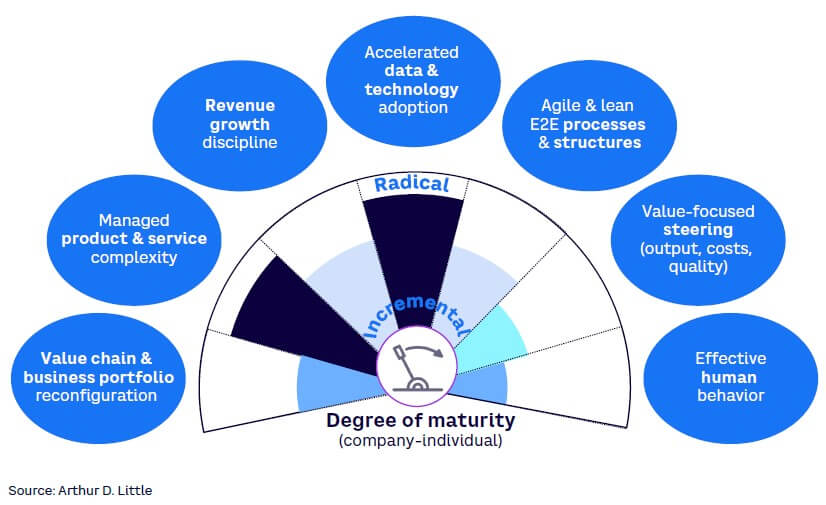
It should be noted that the levers, though implemented internally within the company, always support external ecosystems. For example, levers in products/services and processes are based on the customer ecosystem. These levers require an understanding of the value and demand of products/services for the customer segments along with the processes that impact the customer’s experience. Similarly, data and technologies address the technology ecosystem while people and culture consider the societal ecosystem.
Integration of the levers with external ecosystems enables radical implementation and taps into the full productivity value. Ideally, the optimal levers are selected and combined through a “new game” system to address all challenges simultaneously (see Figure 5). The levers are applied in the productivity framework design and initiative design phases of the Productivity RACE, which we explain in the next section.
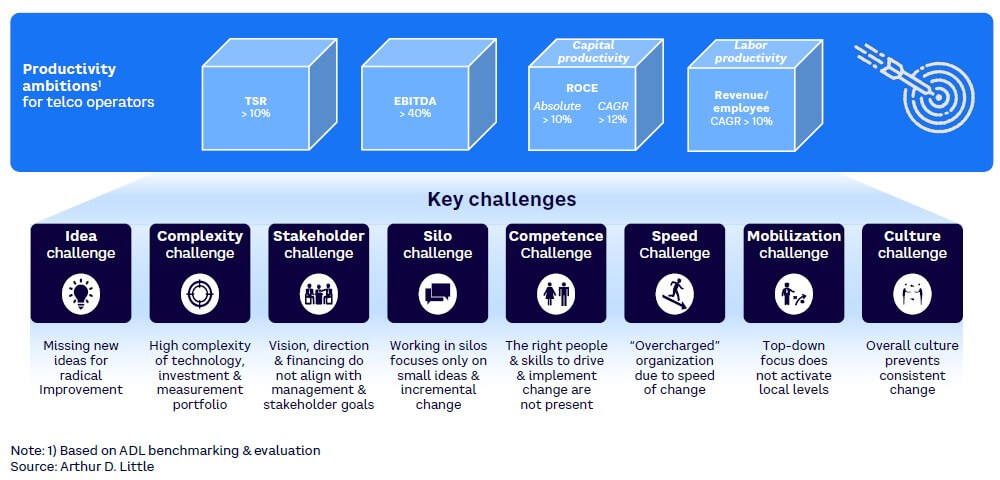
KICKING OFF THE TRANSFORMATION
Initiating a Productivity RACE implementation may seem daunting due to a gamut of challenges to address and a large collection of available levers. A stepwise approach starts with a focused assessment, which is a low-investment way to measure initial awareness of the challenges in the organization.
The first step in a Productivity RACE transformation is the “brutal truth assessment.” The objective of this assessment is to understand the challenges facing the telco and to achieve a holistic overview of maturity, as indicated in Figure 4. The assessment helps management decide on the building blocks of the Productivity RACE program. The major tasks within this step include conducting a hypotheses workshop with senior management — using multiple parameters to analyze and benchmark company performance — and aligning the sprints required in the Productivity RACE.
The framework design is the second step in the Productivity RACE. This step defines the optimal setup to enable a continuous and radical transformation. This includes designing the game system to implement the Productivity RACE, as shown in Figure 5. The team members and critical resources needed to enact the Productivity RACE are identified and activated. Preparations are made to restart the system and mitigate disruptions to customers. During this step, management identifies the lighthouse projects for execution that will produce quick results.
The third (and longest) step is program delivery and organization enablement. In this step, productivity is fostered in the selected lighthouse areas. The organization adopts the new systems and processes using a suitable operating model, capability development, and mindset change. A program management office steers the undertaking by supporting the organization and tracking well-defined KPIs.
SUCCESSFULLY IMPLEMENTING THE PRODUCTIVITY RACE
Shareholders of a European telco were pressuring management to achieve strong profitability growth in order to sustain the dividend policy. Multiple factors had created high complexity in the telco’s internal operations. Its offer structure included more than 1,000 legacy products in operations support systems and business support systems. The IT landscape was also complex due to the existence of legacy systems and the rise of new systems from acquisitions and post-merger integrations. Challenging regulations and intense competition from over-the-top players, alt-nets, and mobile virtual network operators created simultaneous external complexities for the telco.
The telco adopted “radical simplification” as the approach toward improving its productivity. Radical simplification required the understanding of key interdependencies and addressing all domains within the company. This included product, channel, process, technological, and corporate complexity. Several levers were identified with specific targets on each (see Figure 6).
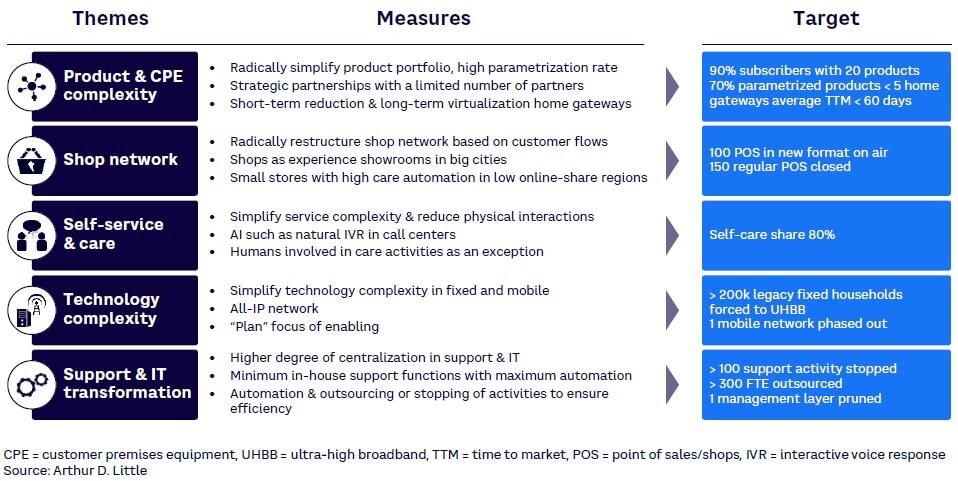
A complexity reduction blueprint estimated the need for a reduction in headcount of 50%, with an EBITDA impact of around 40%. The strategy of setting and scoping was followed by several sprints per simplification theme, followed by consolidation and rescoping as required. The telco’s overall operating model was adapted to support the simplification in a sustainable manner.
Key success factors included:
-
Aligning telco executives with objectives and the need to change, which was driven by board-level requirements.
-
Addressing all domains of the company.
-
Following an agile approach for implementation.
Another telco in a Middle Eastern market had already run multiple cycles of productivity programs positioned as business/cost-efficiency initiatives, but was unsuccessful in achieving substantial results. The primary reason for failure was the decision against adopting a company-wide transformation. Such initiatives, typically driven by an organization’s finance unit, focused on benchmarking the company performance against its peers and lowering costs in specific areas. This approach was not underpinned by a business-driven view of the company’s operations and fixing the root causes of lower efficiency levels. Initiatives based on top-down push to remedy benchmarking gaps do not muster wide-scale acceptance from the people, which is essential for concrete and radical changes to both operations and ways of working. In most cases, this approach is bound to fail as it is unsustainable and cannot be adopted at scale.
Conclusion
IT’S TIME FOR THE BRUTAL TRUTH
The current market environment and competitive situations make the Productivity RACE an important program for operators to consider now. While traditional cost-efficiency programs get results in the short term, the Productivity RACE aims for a holistic, sustainable transformation for telcos. The Productivity RACE offers a comprehensive set of strategic, financial, technological, and operational levers, including infrastructure carve-outs, digital channel adoption, customer lifecycle management, and network function virtualization. Telcos, under pressure from various fronts, must act consistently to turn around their core businesses. Therefore, telco executives should table the productivity ambition on the executive management agenda and push for a brutal-truth assessment to initiate the Productivity RACE program.




